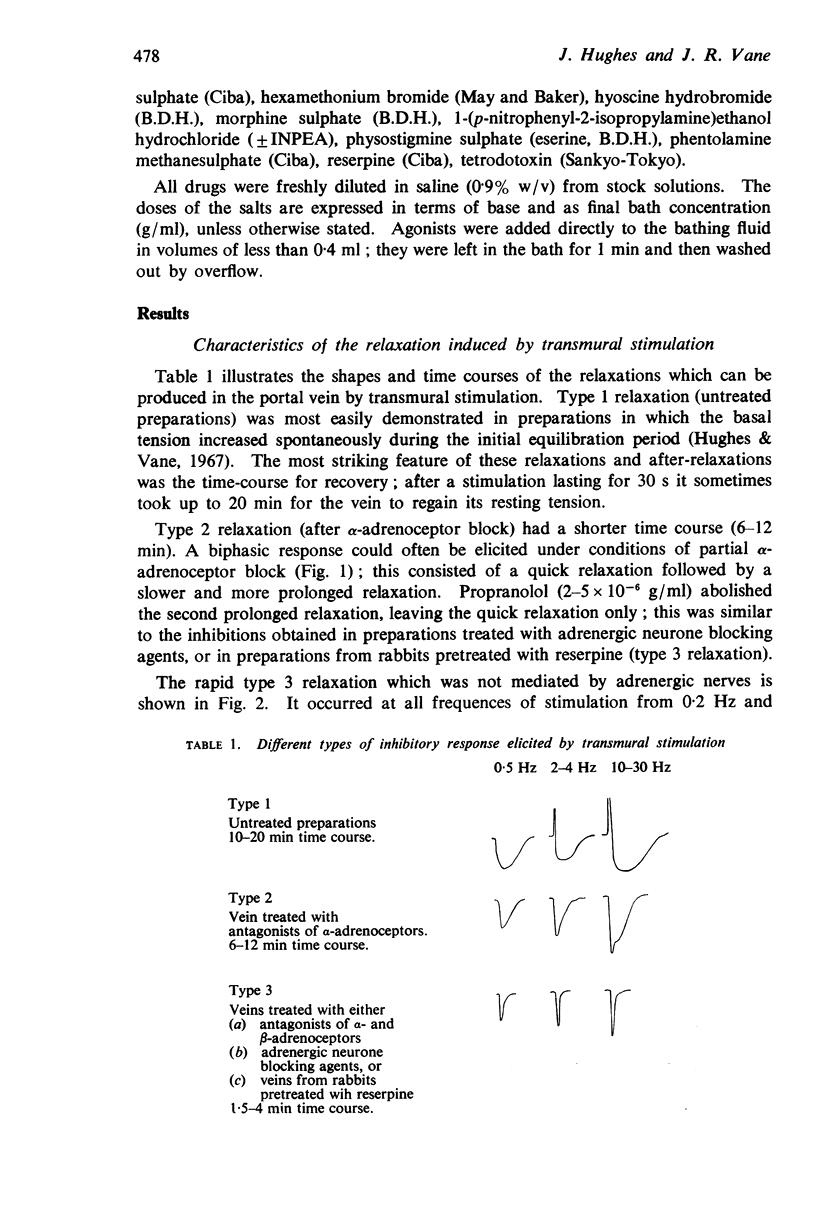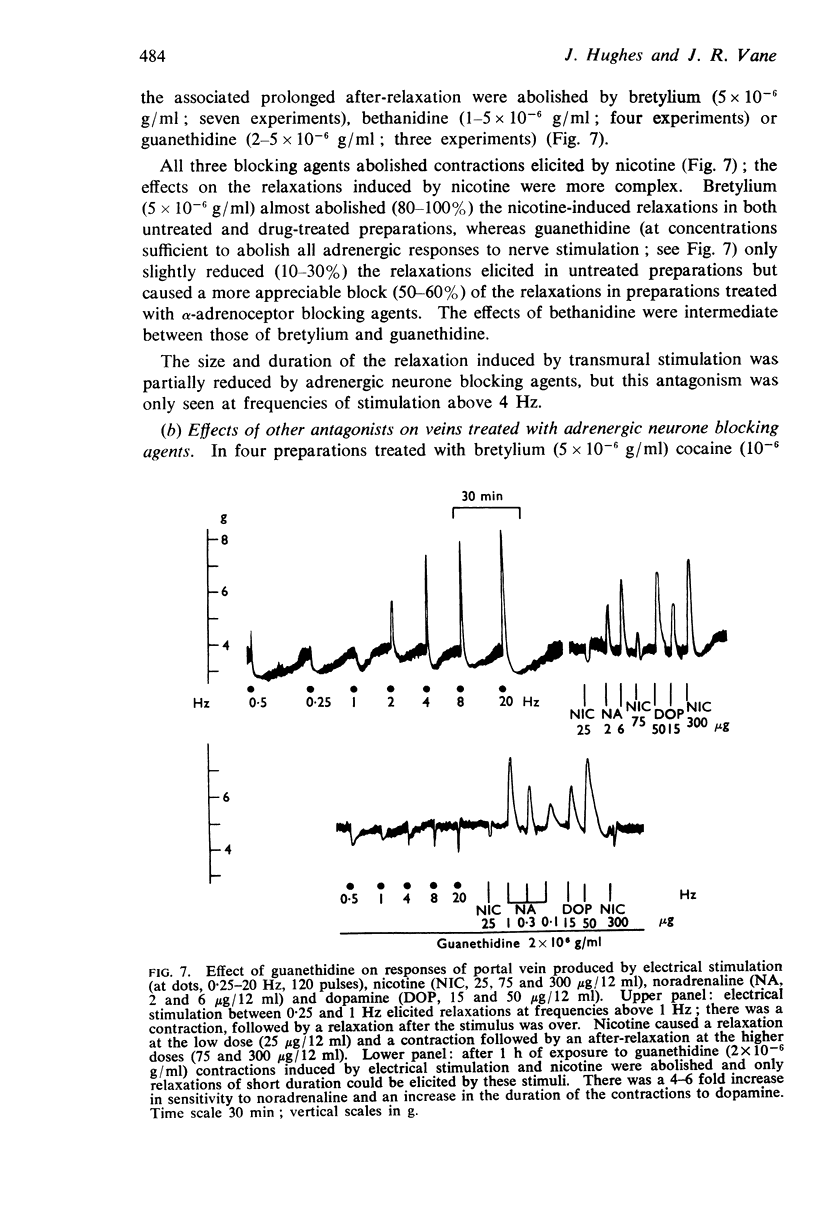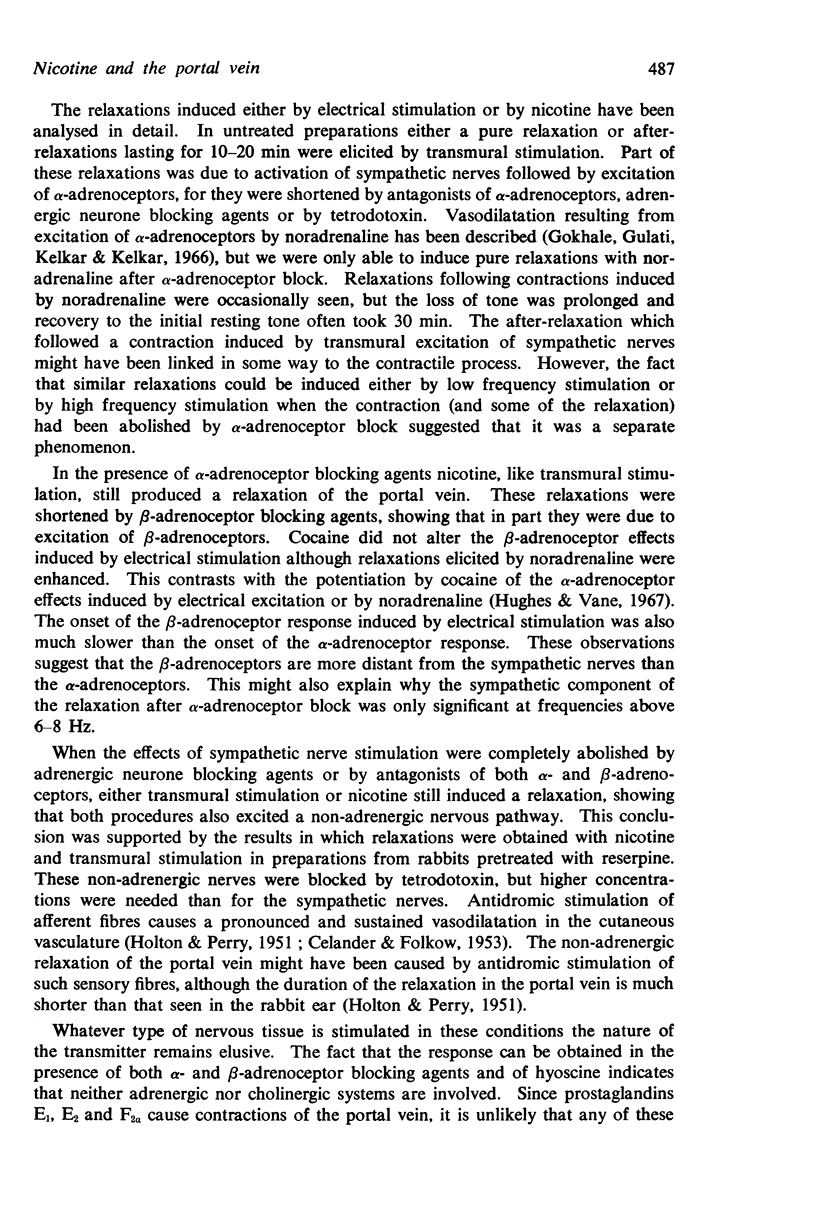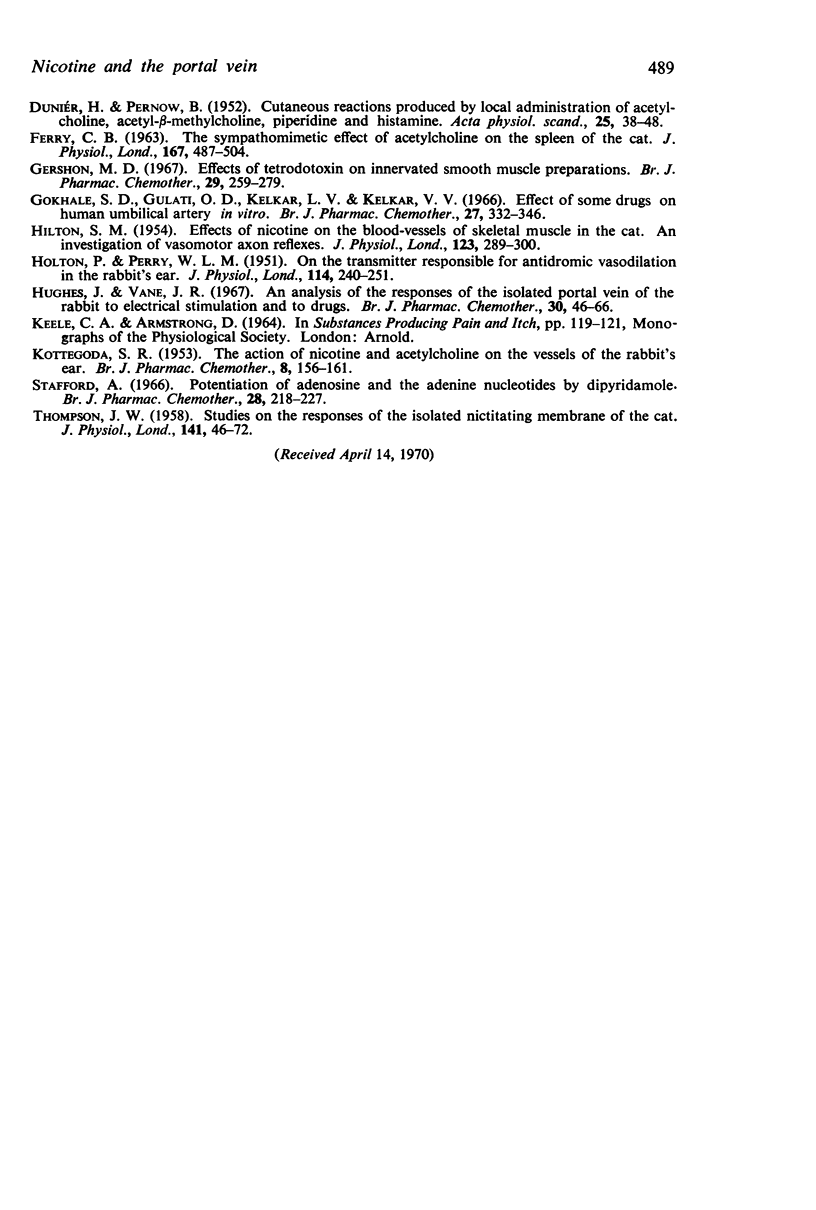Abstract
1. A pharmacological analysis of the inhibitory innervation of the isolated portal vein of the rabbit has been made.
2. In untreated preparations, transmural stimulation elicited a long-lasting relaxation at low frequencies (0·2-1 Hz); at higher frequencies a contraction followed by a prolonged after-relaxation occurred. Tetrodotoxin abolished the contractions but a higher dose was required to abolish the relaxations. Veratrine lowered the threshold of stimulation for producing relaxations in the untreated vein. The relaxations were unaffected by hyoscine or hexamethonium. They were reduced or altered by antagonists of α-adrenoceptors for catecholamines and by adrenergic neurone blockade. They were sometimes slightly reduced by antagonists of β-adrenoceptors.
3. In the presence of antagonists of α-adrenoceptors, electrical stimulation elicited relaxations which increased with frequency of stimulation and became maximal at 20-30 Hz. These relaxations were partially reduced by antagonists of β-adrenoceptors, or by adrenergic neurone block; the antagonisms were more pronounced at the higher frequencies of stimulation. Noradrenaline also caused relaxations which were abolished by β-adrenoceptor blocking drugs. Cocaine increased the sensitivity to noradrenaline by 7-8 fold after α-adrenoceptor blockade but had little or no effect on the relaxations induced by electrical stimulation at high frequencies.
4. In the presence of antagonists of α- and β-adrenoceptors, or adrenergic neurone blocking agents, or in veins taken from rabbits pretreated with reserpine, electrical stimulation elicited rapid relaxations which were greatest at 20-30 Hz. These relaxations were increased by veratrine and abolished by tetrodotoxin or by storing the vein for 9 days at 4° C. They were unaffected by antagonists of acetylcholine, or by dipyridamole.
5. Prostaglandins E1, E2 and F2α inhibited contractions elicited by electrical stimulation and noradrenaline, but in higher doses caused contractions themselves.
6. Nicotine (10-6-10-5 g/ml) relaxed the portal vein; higher concentrations elicited mixed inhibitory and excitatory effects. All these effects were abolished by tetrodotoxin, cocaine, hexamethonium or storage. The contractor effects were abolished by drugs or procedures that blocked adrenergic mechanisms.
7. The relaxations produced by nicotine in untreated preparations and in veins from rabbits pretreated with reserpine were mediated mainly by a non-adrenergic non-cholinergic nervous mechanism. Relaxations induced by nicotine in the presence of antagonists of a-adrenoceptors were only partially antagonized by antagonists of f3-adrenoceptors.
8. It was concluded that all the effects of nicotine and transmural stimulation were mediated by nerves. Part of the inhibitory effects was mediated by non-adrenergic, non-cholinergic nerves.
Full text
PDF













Selected References
These references are in PubMed. This may not be the complete list of references from this article.
- BURN J. H., LEACH E. H., RAND M. J., THOMPSON J. W. Peripheral effects of nicotine and acetylcholine resembling those of sympathetic stimulation. J Physiol. 1959 Oct;148:332–352. doi: 10.1113/jphysiol.1959.sp006291. [DOI] [PMC free article] [PubMed] [Google Scholar]
- Brandon K. W., Rand M. J. Acetylcholine and the sympathetic innervation of the spleen. J Physiol. 1961 Jun;157(1):18–32. doi: 10.1113/jphysiol.1961.sp006702. [DOI] [PMC free article] [PubMed] [Google Scholar]
- Brown G. L., Gray J. A. Some effects of nicotine-like substances and their relation to sensory nerve endings. J Physiol. 1948 Jun 25;107(3):306–317. doi: 10.1113/jphysiol.1948.sp004275. [DOI] [PMC free article] [PubMed] [Google Scholar]
- Burnstock G., Campbell G., Rand M. J. The inhibitory innervation of the taenia of the guinea-pig caecum. J Physiol. 1966 Feb;182(3):504–526. doi: 10.1113/jphysiol.1966.sp007834. [DOI] [PMC free article] [PubMed] [Google Scholar]
- CELANDER O., FOLKOW B. The correlation between the stimulation frequency and the dilator response evoked by 'antidromic' excitation of the thin afferent fibres in the dorsal roots. Acta Physiol Scand. 1953 Nov 17;29(4):371–376. doi: 10.1111/j.1748-1716.1953.tb01031.x. [DOI] [PubMed] [Google Scholar]
- Cabrera R., Torrance R. W., Viveros H. The action of acetyl choline and other drugs upon the terminal parts of the postganglionic sympathetic fibre. Br J Pharmacol Chemother. 1966 May;27(1):51–63. doi: 10.1111/j.1476-5381.1966.tb01641.x. [DOI] [PMC free article] [PubMed] [Google Scholar]
- DALY M. D., SCOTT M. J. The effects of acetylcholine on the volume and vascular resistance of the dog's spleen. J Physiol. 1961 Apr;156:246–259. doi: 10.1113/jphysiol.1961.sp006673. [DOI] [PMC free article] [PubMed] [Google Scholar]
- DOUGLAS W. W., GRAY J. A. B. The excitant action of acetylcholine and other substances on cutaneous sensory pathways and its prevention by hexamethonium and D-tubocurarine. J Physiol. 1953 Jan;119(1):118–128. doi: 10.1113/jphysiol.1953.sp004832. [DOI] [PMC free article] [PubMed] [Google Scholar]
- DUNER H., PERNOW B. Cutaneous reactions produced by local administration of acetylcholine, acetyl-beta-methylcholine, piperidine and histamine. Acta Physiol Scand. 1952;25(1):38–48. doi: 10.1111/j.1748-1716.1952.tb00857.x. [DOI] [PubMed] [Google Scholar]
- FERRY C. B. The synpathomimetic effect of acetylcholine on the spleen of the cat. J Physiol. 1963 Jul;167:487–504. doi: 10.1113/jphysiol.1963.sp007164. [DOI] [PMC free article] [PubMed] [Google Scholar]
- Gershon M. D. Effects of tetrodotoxin on innervated smooth muscle preparations. Br J Pharmacol Chemother. 1967 Mar;29(3):259–279. doi: 10.1111/j.1476-5381.1967.tb01958.x. [DOI] [PMC free article] [PubMed] [Google Scholar]
- HILTON S. M. The effects of nicotine on the blood vessels of skeletal muscle in the cat; an investigation of vasomotor axon reflexes. J Physiol. 1954 Feb 26;123(2):289–300. doi: 10.1113/jphysiol.1954.sp005051. [DOI] [PMC free article] [PubMed] [Google Scholar]
- HOLTON P., PERRY W. L. M. On the transmitter responsible for antidromic vasodilatation in the rabbit's ear. J Physiol. 1951 Jun;114(1-2):240–251. doi: 10.1113/jphysiol.1951.sp004615. [DOI] [PMC free article] [PubMed] [Google Scholar]
- KOTTEGODA S. R. The action of nicotine and acetylcholine on the vessels of the rabbit's ear. Br J Pharmacol Chemother. 1953 Jun;8(2):156–161. doi: 10.1111/j.1476-5381.1953.tb00770.x. [DOI] [PMC free article] [PubMed] [Google Scholar]
- Stafford A. Potentiation of adenosine and the adenine nucleotides by dipyridamole. Br J Pharmacol Chemother. 1966 Nov;28(2):218–227. doi: 10.1111/j.1476-5381.1966.tb01888.x. [DOI] [PMC free article] [PubMed] [Google Scholar]
- THOMPSON J. W. Studies on the responses of the isolated nictitating membrane of the cat. J Physiol. 1958 Apr 3;141(1):46–72. doi: 10.1113/jphysiol.1958.sp005954. [DOI] [PMC free article] [PubMed] [Google Scholar]


